When you have a large property with lots of open spaces, privacy is hard. This can be a problem when you would want some quiet time outdoors. But as DIY-ers love to say, every problem has a DIY solution.
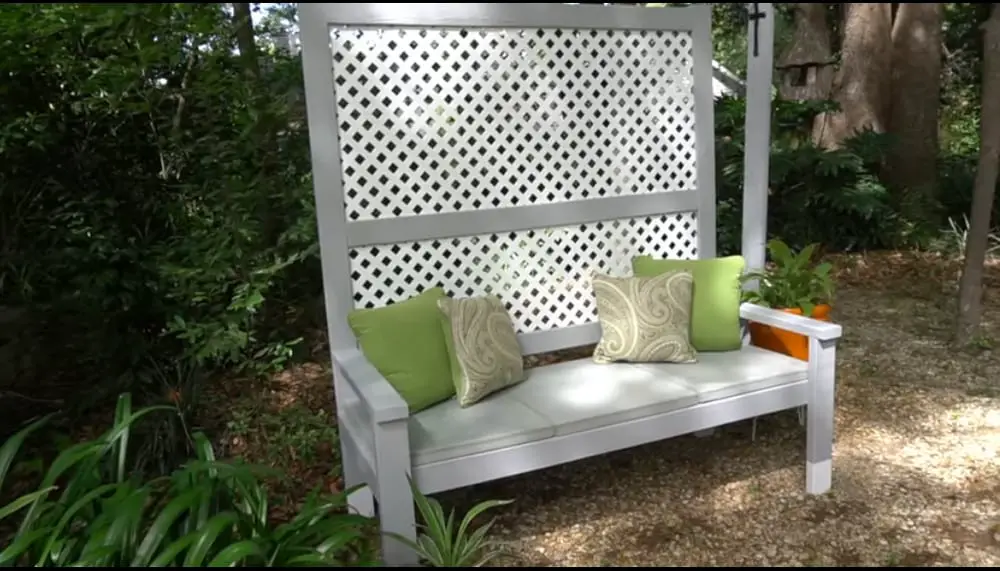
Here’s a bench that you can set up in your backyard. It provides you with much-needed privacy, away from the prying eyes of your neighbors. This is perfect for lazy days when you want to immerse yourself in a good book.

It would be great if you have help in building this bench. Concrete can get pretty heavy so you’ll be needing an extra pair of hands.
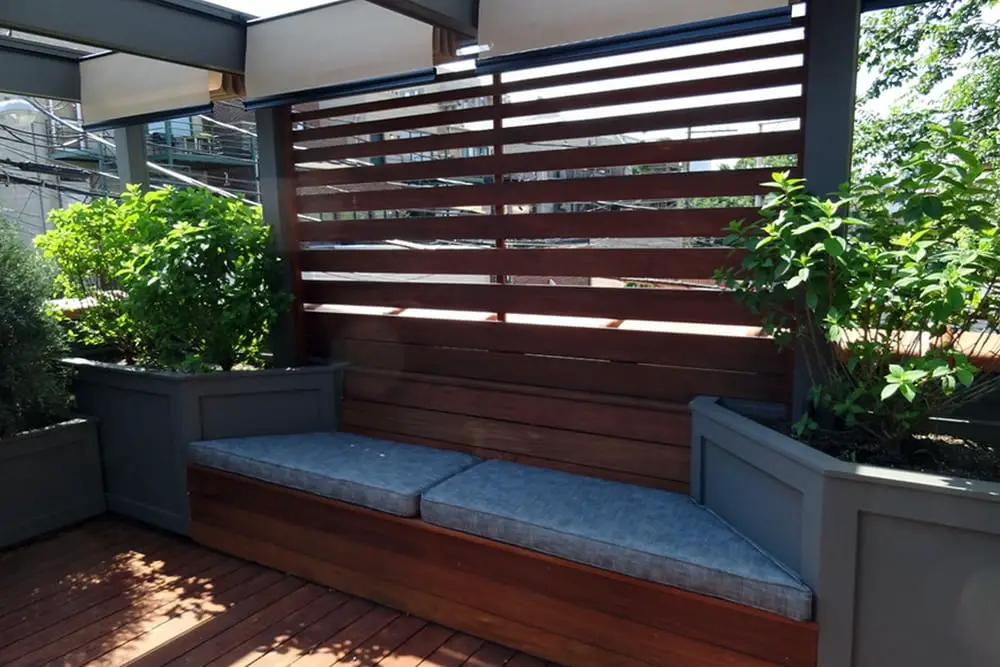
There are those who made an outdoor privacy bench using wood instead of concrete. Because the design is fully customizable, you’re free to do whatever you want.
Contents
Building an Outdoor Privacy Bench
Materials
- 9 pcs 8” pressure treated 2X4s
- 4’x8′ plastic privacy lattice
- 2.5” Kreg outdoor screws
- 4 pcs strong tie brackets
- Behr outdoor wood primer
- Behr outdoor gray paint
- White flex seal rubber paint
- Bondo
- Wood filler
- Outdoor wood glue
Tools
- Kreg K4 pocket hole jig
- Ryobi circular saw
- Kreg rip cut circular saw jig
- Miter saw
- Chisels
- Speed square
- Orbital sander
- Tin snips
- Tape measure, level, clamps
- Ryobi impact driver
- Ryobi drill/driver
- Safety equipment—gloves, face mask, eye protection
Instructions
Preparation
- Safety First: Before starting, wear your safety equipment: gloves, face mask, and eye protection.
- Measure and Plan: Use the tape measure and speed square to plan the dimensions of your bench. Consider the height, width, and depth that will best fit your outdoor space.
Cutting the Wood
- Cut the 2X4s: Using the Ryobi circular saw and Kreg rip cut circular saw jig, cut the 2X4s to the desired lengths for the frame of your bench. You’ll need four pieces for the legs, four pieces for the frame’s length, and several pieces for the frame’s width and seating slats.
- Prepare the Lattice: With tin snips, cut the plastic privacy lattice to fit the back and sides of your bench, if desired, for added privacy.
Assembling the Frame
- Drill Pocket Holes: Use the Kreg K4 pocket hole jig to drill pocket holes at the ends of the frame pieces for a stronger hold.
- Assemble the Frame: Join the frame pieces using the 2.5” Kreg outdoor screws. Start by creating the rectangular base, then attach the legs, and finally, add the top frame that will support the seating slats.
Adding the Seating Slats
- Cut Seating Slats: Cut additional 2X4s to the length of the bench for the seating slats. Space them evenly across the top frame.
- Secure Slats to Frame: Attach the seating slats to the frame using outdoor screws. Ensure they are evenly spaced for comfort and aesthetics.
Attaching the Lattice
- Attach Lattice for Privacy: Use the wood glue and screws to attach the cut lattice pieces to the back and sides of the bench. The lattice will provide privacy while adding a decorative touch.
Finishing Touches
- Sanding: Use the orbital sander to smooth all surfaces of the bench, focusing on edges and seating slats to prevent splinters.
- Apply Primer and Paint: First, apply a coat of Behr outdoor wood primer to all wooden surfaces. Once dry, apply the Behr outdoor gray paint to the wood and the white flex seal rubber paint to the lattice for a cohesive look.
- Fill Gaps: Use wood filler and Bondo to fill any gaps or holes in the wood, then sand smooth once dry.
Final Assembly
- Install Strong Tie Brackets: For additional support, install the strong tie brackets at each corner of the bench frame, using the Ryobi drill/driver to secure them in place.
- Level and Secure Bench: Place your bench in its intended location. Use the level to ensure it is even, and adjust as necessary. You may anchor the bench to the ground or leave it movable, depending on your preference and the bench’s weight.
Landscaping for Enhanced Privacy
Creating a secluded haven in your outdoor space is not only about adding an outdoor privacy bench; it’s also about the surrounding landscape that enhances the sense of privacy and tranquility. Thoughtful landscaping can transform your bench into a hidden retreat, shielded from neighbors and the hustle and bustle of daily life.
Below, we delve into how to use landscaping to bolster the privacy around your outdoor privacy bench, ensuring a serene escape in your backyard.
Selecting the Right Plants
Evergreen trees and shrubs are the backbone of any privacy landscaping plan. They provide constant coverage and a lush backdrop for your outdoor privacy bench, ensuring seclusion throughout the year. Consider varieties like arborvitae, boxwood, or holly to create a dense, green wall around your seating area.
While they may not offer year-round privacy, deciduous trees and shrubs add seasonal interest and can provide substantial coverage during the months you’re most likely to use your outdoor privacy bench. Maples, dogwoods, and lilacs enhance privacy in spring and summer and add color and fragrance to your garden.
Incorporating Climbing Plants
A trellis or pergola over or around your outdoor privacy bench can support climbing plants, creating a living canopy with shade and privacy. Vines like clematis, jasmine, or climbing roses add beauty and fragrance, making your privacy bench a more inviting destination.
Planting climbing vines directly in the ground around your outdoor privacy bench and allowing them to grow up existing fences or custom-made frames can create a vibrant, natural screen. This method provides privacy while seamlessly integrating your seating area into the landscape.
Strategic Plant Placement
Layering plants of different heights and types can create a more natural and effective privacy screen. Start with taller trees in the back, add shrubs at a medium height, and finish with lower plants and flowers in front. This approach enhances privacy around your outdoor privacy bench and adds depth and interest to your garden.
Use striking plants or features as focal points to draw the eye away from less private areas. A beautifully planted flower bed or a stunning garden sculpture can divert attention, making the space around your outdoor privacy bench more secluded.
Maintenance and Growth Considerations
Understanding Growth Patterns
When selecting plants for privacy, consider their mature size and growth rate. Fast-growing plants may offer quick coverage but can also become unmanageable. Opt for species that grow to the desired height and width, minimizing the need for frequent trimming.
Regular Care and Pruning
Regular maintenance is key to ensuring that your privacy landscaping remains effective and beautiful. Pruning keeps plants healthy and manageable and can help shape your greenery to provide optimal coverage around your outdoor privacy bench.
Landscaping around your outdoor privacy bench with these strategies can create a private, peaceful retreat that feels worlds away from the outside. Selecting and arranging the right plants lets you can enjoy a secluded spot in your garden that invites relaxation and contemplation, surrounded by the beauty of nature.
Click on any image to start the lightbox display. Use your Esc key to close the lightbox.

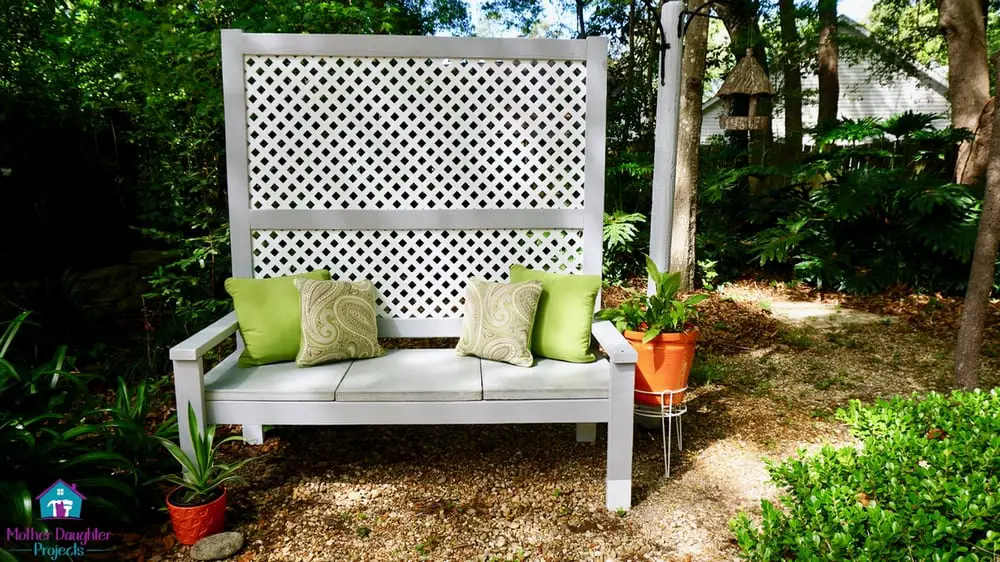
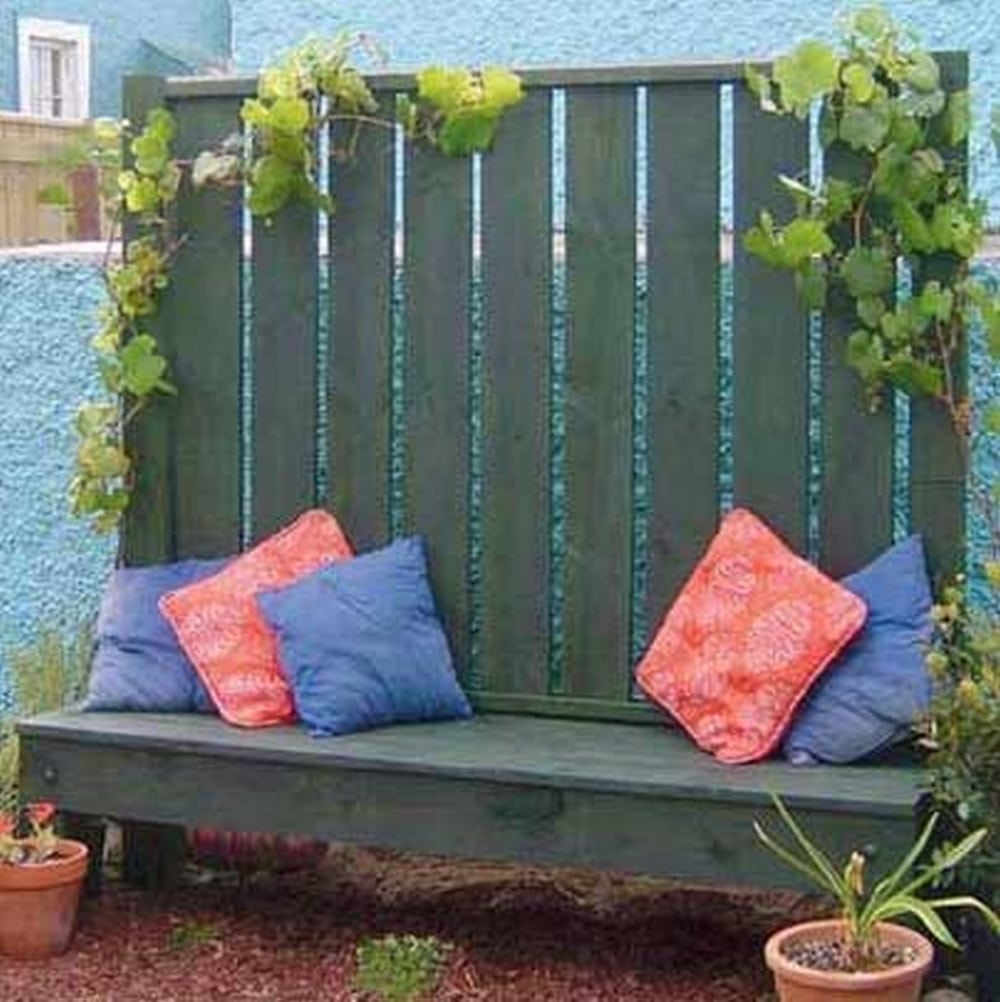
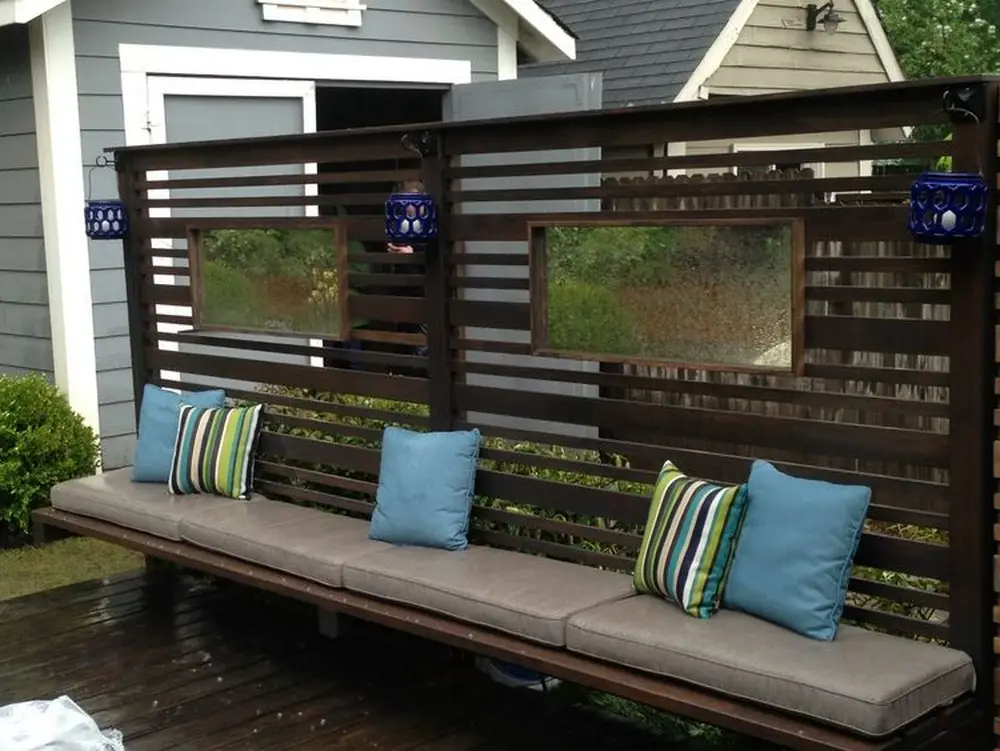

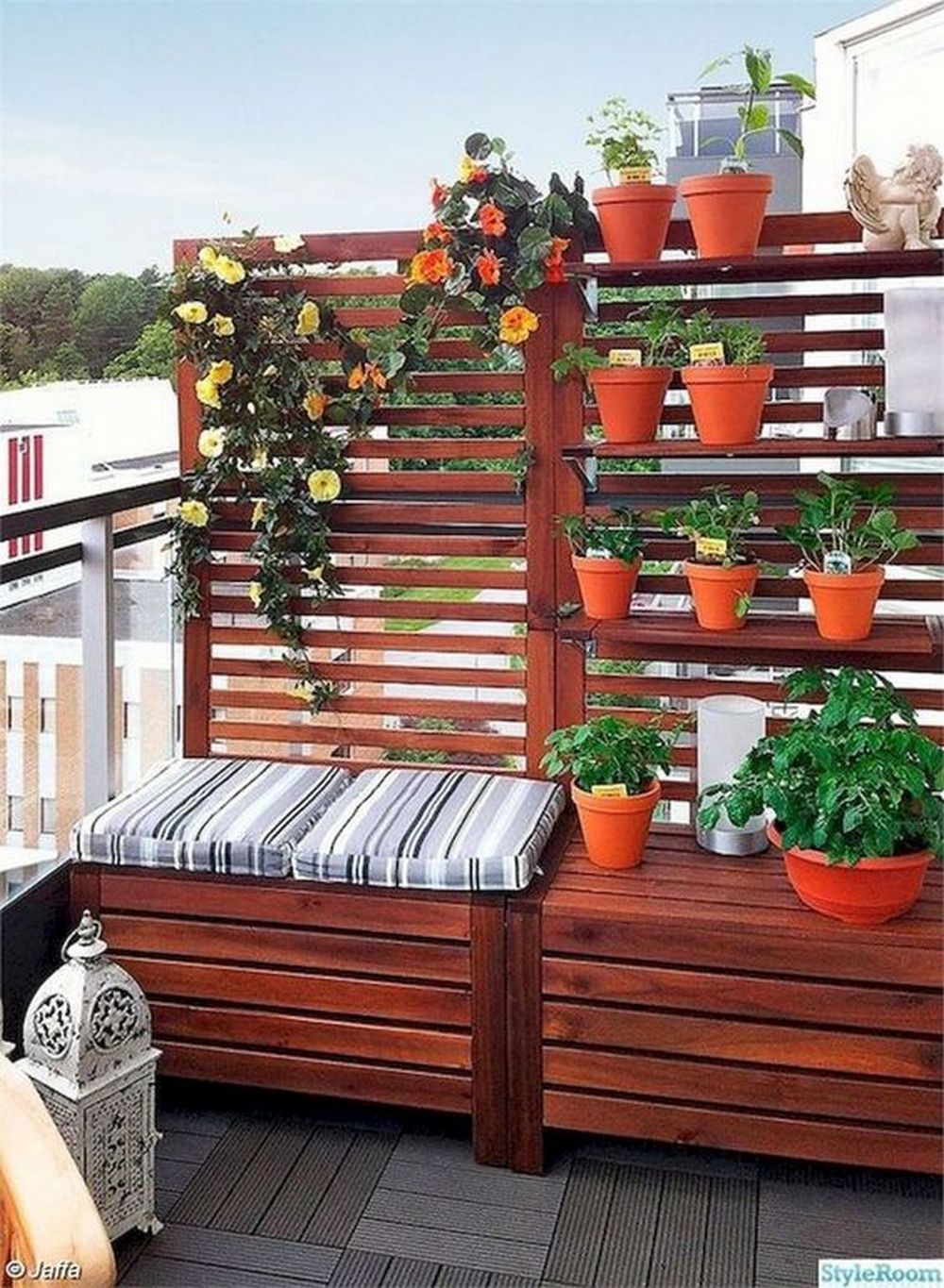

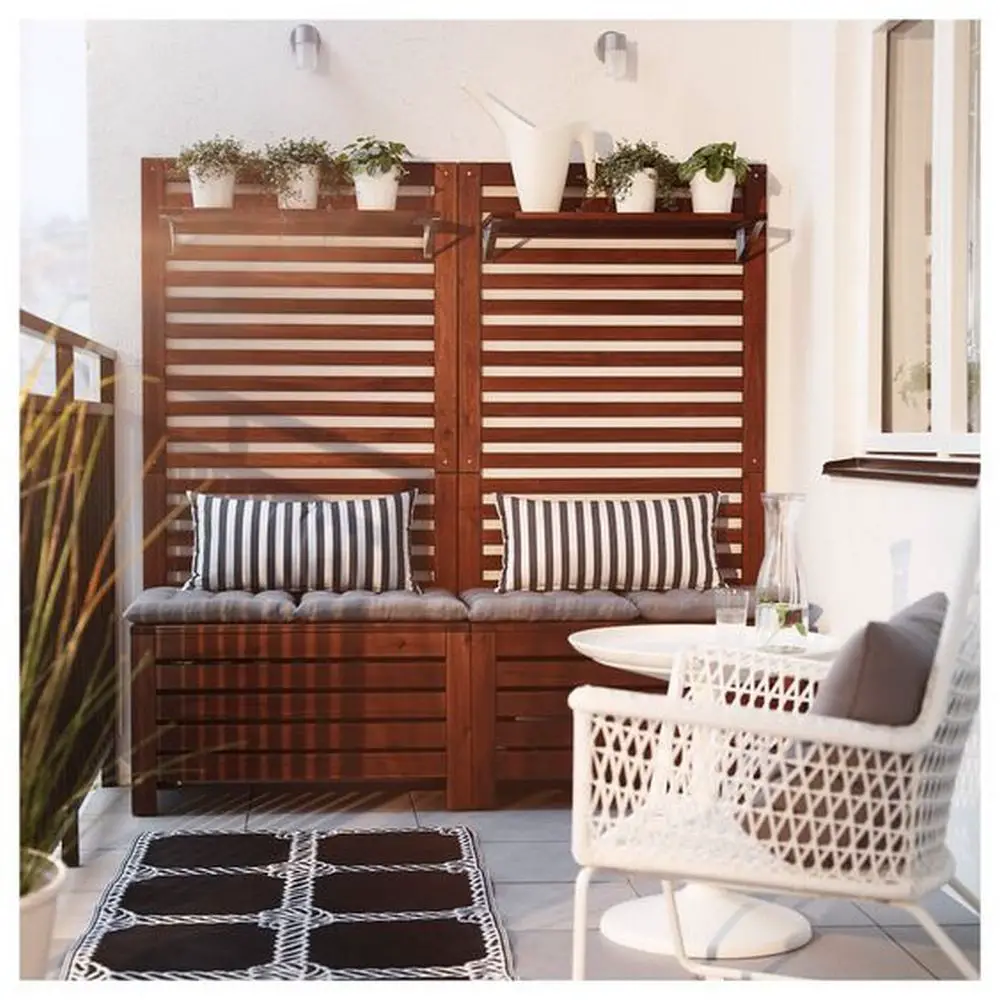
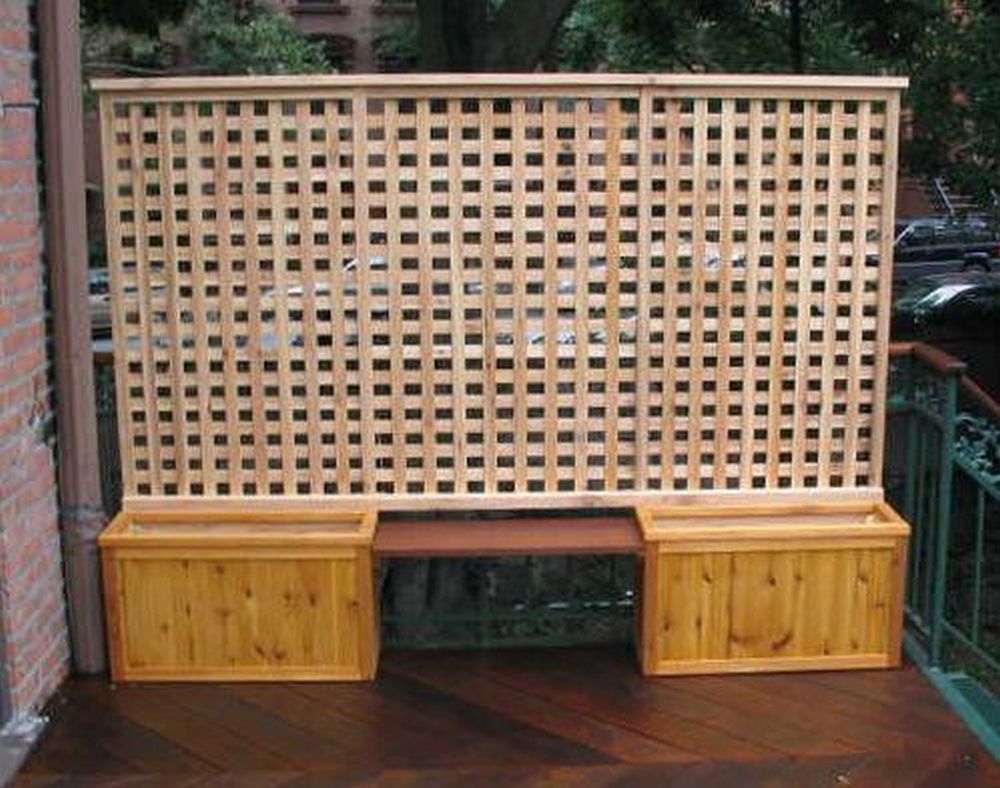
Thanks to MotherDaughterProjects for this great project. You can get step-by-step instructions here…
Alternative Materials and Their Advantages
When constructing an outdoor privacy bench, choosing the right material is crucial for both aesthetics and durability. While wood and concrete are traditional choices, exploring alternative materials can offer unique benefits and transform your outdoor space into a stylish and functional retreat.
Let’s delve into some of these alternative materials for your outdoor privacy bench and discuss their advantages, ensuring you make an informed decision for your project.
Recycled Plastic Lumber
Recycled plastic lumber is an excellent alternative for those looking to make an environmentally friendly choice for their outdoor privacy bench. Made from recycled plastic bottles and containers, it’s a sustainable option that reduces landfill waste.
Unlike wood, recycled plastic lumber does not rot, splinter, or require painting or staining. This makes it an ideal material for outdoor privacy benches, offering a long-lasting seating solution with minimal upkeep.
Composite Materials
Composite materials, a blend of wood fibers and plastic, offer the natural look of wood without maintenance. Composites in various colors and textures can match any outdoor decor, making them a versatile choice for your outdoor privacy bench.
Composite materials are designed to withstand harsh weather conditions, including rain, sun, and snow, without warping, fading, or cracking. They also resist pests, ensuring your outdoor privacy bench remains pristine for years.
Metal
For those seeking a contemporary aesthetic, metal can be a fantastic choice for an outdoor privacy bench. Materials like aluminum or powder-coated steel provide a sleek, modern look that can complement any urban or minimalist garden design.
Metal benches are incredibly durable and can handle heavy use without showing signs of wear. They are also resistant to rust and corrosion, especially when treated with a protective coating, making them a lasting addition to your outdoor space.
Stone and Concrete
While concrete was mentioned briefly, expanding the use of stone and concrete can add timeless elegance to your garden. These materials can be molded or shaped into unique designs that enhance the privacy and ambiance around your outdoor privacy bench.
Stone and concrete naturally maintain a cool temperature, making them comfortable seating options during warmer months. They also blend seamlessly with the outdoor environment, providing a sturdy and weather-resistant seating solution.
Bamboo
Bamboo is a fast-growing grass, making it an eco-friendly material choice for an outdoor privacy bench. It offers a unique, natural look that can add warmth and exotic flair to your outdoor space.
Despite its lightweight nature, bamboo is incredibly strong and flexible, making it durable for outdoor furniture. It also has a natural resistance to pests and decay, ensuring your bench remains a beautiful part of your garden for years.
Choosing the right material for your outdoor privacy bench involves balancing aesthetics, maintenance, and sustainability. Whether you opt for recycled plastic, composite materials, metal, stone, or bamboo, each option presents unique advantages that can enhance your outdoor space’s beauty, functionality, and privacy.
Incorporating Privacy Benches into Small Spaces
Incorporating an outdoor privacy bench into small spaces presents a unique set of challenges. Still, thoughtful design and strategic placement can transform a cramped area into a cozy, secluded retreat. The key lies in maximizing the available space while ensuring that the addition of a privacy bench enhances the outdoor area’s functionality and aesthetic appeal.
Let’s explore how to effectively integrate an outdoor privacy bench into small spaces, making the most of limited square footage.
Optimize Vertical Space
In smaller outdoor areas, vertical planters can serve a dual purpose: they add greenery and privacy without taking up valuable floor space. Positioning a vertical garden around your outdoor privacy bench creates a lush backdrop and enhances the sense of seclusion, making the space feel more expansive.
Tall privacy screens or lattice panels can be installed directly behind the outdoor privacy bench, providing immediate privacy without infringing on the limited ground area. These screens can be adorned with climbing plants or decorative elements to add visual interest and a personal touch.
Choose Multi-Functional Furniture
Select an outdoor privacy bench that offers built-in storage underneath. This smart design allows for the stowing away of garden tools, cushions, or outdoor toys, keeping the area tidy and maximizing functionality within a small footprint.
Opt for a foldable or modular outdoor privacy bench that can easily adjust or move according to your needs. These flexible designs are ideal for small spaces, allowing for rearranging your outdoor area for different occasions or seasons.
Select the Right Placement
Placing the outdoor privacy bench in a corner of your garden or patio can capitalize on unused space and create a private nook. This placement also allows for the addition of corner plant stands or small trees to enhance privacy without overcrowding the area.
Installing the bench alongside an existing fence or wall can provide an instant backdrop that defines the space. This setup maximizes the usable area while the vertical surface can be utilized for hanging plants, outdoor art, or additional privacy enhancements.
Integrate with Landscaping
Make your outdoor privacy bench the focal point of your small outdoor space by arranging potted plants, lighting, and decorative elements. This approach draws the eye towards the bench, making the surrounding area more spacious and inviting.
Incorporating ground cover plants and low-growing shrubs around the bench can blur the boundaries of the space, creating the illusion of a larger garden. This landscaping strategy enhances privacy and adds depth and texture to the outdoor area.
Incorporating an outdoor privacy bench into small spaces requires creativity and strategic planning. With these tips, your outdoor privacy bench will fit seamlessly into your space, enhancing its overall charm and usability.
Budgeting and Cost-Saving Tips
Creating a serene outdoor space with an outdoor privacy bench doesn’t have to strain your finances. With smart planning and strategic choices, you can build a beautiful and private outdoor retreat while adhering to your budget.
Here are some cost-saving tips and budgeting advice to help you achieve your vision without compromising on quality or aesthetics.
Plan and Set a Budget
Before purchasing materials or starting construction, have a clear design for your outdoor privacy bench. This plan should include dimensions, materials, and any additional features like storage or planters. A detailed plan helps avoid costly mistakes or purchasing unnecessary materials.
Based on your plan, set a realistic budget for your project. Consider all potential costs, including materials, tools (if you don’t already own them), and any additional landscaping. Don’t forget to factor in a contingency of 10-15% for unexpected expenses.
Choose Cost-Effective Materials
While exotic woods are beautiful, they can be expensive. Consider more affordable alternatives like pine or cedar, which can still offer durability and aesthetic appeal for your outdoor privacy bench. Treat them with the appropriate sealants to enhance longevity.
Look for opportunities to recycle or repurpose materials. Pallets, for instance, can be a great resource for wood and can often be obtained for free or at a low cost. Repurposing old furniture parts or other materials can also add character to your bench while saving money.
DIY Where Possible
Labor costs can significantly increase the price of outdoor projects. By taking on the construction of your outdoor privacy bench yourself, you can save on these expenses. Utilize online tutorials, forums, and guides to bolster your knowledge and confidence.
If you don’t own the necessary tools, consider borrowing them from friends or family. Many hardware stores also offer tool rental services, which can be a cost-effective alternative to purchasing expensive equipment for a one-time project.
Shop Smart
Keep an eye out for sales at local hardware stores or online. End-of-season sales are particularly good times to purchase outdoor furniture and materials at a discount. Signing up for newsletters or following stores on social media can alert you to upcoming deals.
Before making any purchases, compare prices between different suppliers. Buying materials in bulk can also lead to savings, especially if you plan on using the same materials for other projects around the garden.
Simplify Design Elements
While intricate designs may be appealing, they often require more materials and a higher skill level, increasing costs. Simplifying your outdoor privacy bench design can reduce both complexity and expense.
Consider what aspects of the bench are most important to you. Prioritizing functionality over decorative details can help decrease costs while providing a private and comfortable outdoor seating area.
Conclusion
Building an outdoor privacy bench is an enriching DIY project that elevates the aesthetics of your outdoor space and provides a secluded sanctuary for relaxation and enjoyment. Using our instructions ensures a durable and attractive outdoor structure. This project offers an opportunity to hone your woodworking skills and allows you to customize your outdoor living area to suit your privacy needs and personal style.
For more ways to enhance your outdoor space, check out our guide on designing garden paths.





